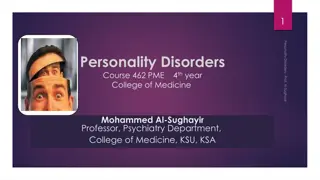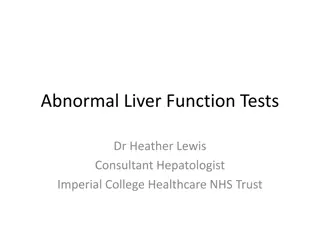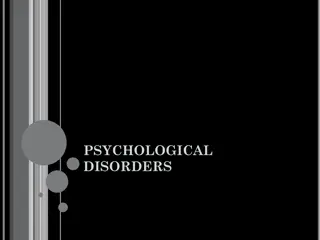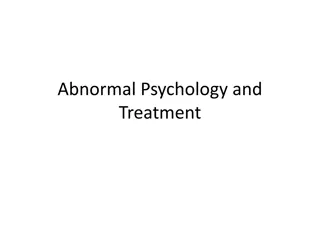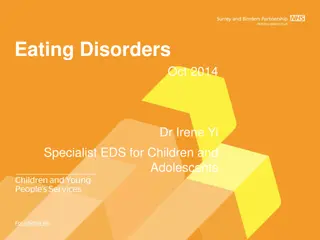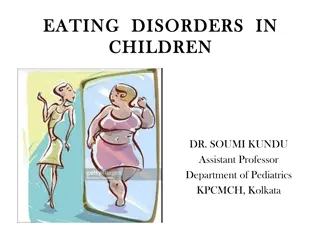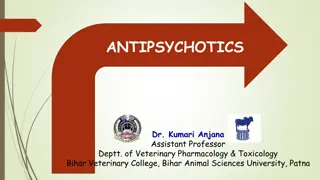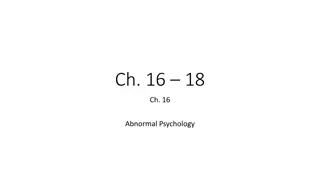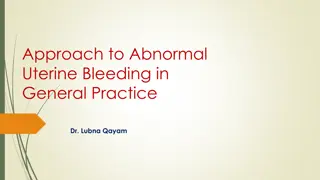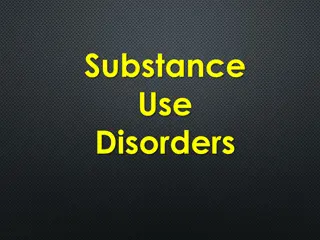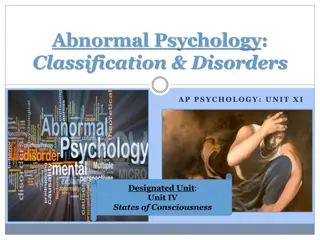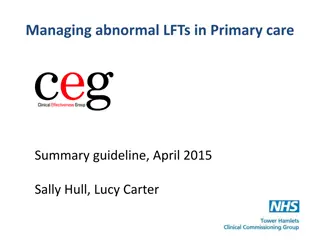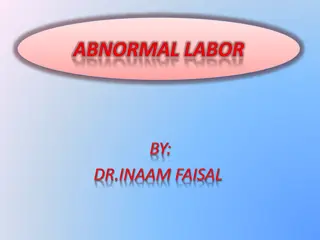Understanding Psychological Disorders: Theoretical Approaches and Abnormal Behavior
Explore the realm of psychological disorders through theoretical approaches such as the Biological, Psychological, and Sociocultural models. Delve into the complexities of abnormal behavior, including definitions and examples. Gain insights into the impact of biological, psychological, and sociocultural factors on mental health and wellness.
Download Presentation

Please find below an Image/Link to download the presentation.
The content on the website is provided AS IS for your information and personal use only. It may not be sold, licensed, or shared on other websites without obtaining consent from the author. Download presentation by click this link. If you encounter any issues during the download, it is possible that the publisher has removed the file from their server.
E N D
Presentation Transcript
Psychological Disorders Chapter 15 AP Psychology Alice F. Short Hilliard Davidson High School
Chapter Preview Defining/Explaining Abnormal Behavior Anxiety Disorders Mood Disorders Dissociative Disorders Schizophrenia Personality Disorders Psychological Disorders and Health and Wellness
Abnormal Behavior abnormal behavior - behavior that is deviant (atypical) example: washing hands 4x an hour maladaptive (dysfunctional) example: believing that you can hurt people by breathing and hiding away and avoiding people personally distressing (despair) example: feeling extreme shame or guilt over a relatively long period of time NOTE: context matters!
Theoretical Approaches Biological Approach: Medical Model disorders with biological origins Psychological Approach experiences, thoughts, emotions, personality Sociocultural Approach social context Biopsychosocial Model interaction of biological, psychological and sociocultural factors
Theoretical Approaches Biological Approach: Medical Model medical model the view that psychological disorers are medical diseases with biological origin disorders with biological origins abnormalities = mental illnesses patients = afflicted individuals doctors = people who treat the patients
Theoretical Approaches: Psychological Approach psychological approach focuses on experiences, thoughts, emotions, personality in the development and course of psychological disorders
Theoretical Approaches: Sociocultural Approach Sociocultural Approach social context includes: gender, ethnicity, socioeconomic status, family relationships, culture, technological aspects of culture, religious aspects of culture socioeconomic status = greater impact than ethnicity living conditions of poverty = stressful
Theoretical Approaches: Biopsychosocial Model Biopsychosocial Model interaction of biological, psychological and sociocultural factors biological factors (such as genes) psychological factors (such as childhood experiences) sociocultural factors (such as gender)
DSM-V Classification System Advantages provides a common basis for communication helps clinicians make predictions naming the disorder can provide comfort Disadvantages stigma (shame, negative reputation) medical terminology implies internal cause focus on weaknesses ignores strength DISUCSSION: Which do you think is more significant the advantages or disadvantages?
Critical Controversy: Psychological Disorders Real or Myth? Szasz & Cruise phrase mental illness is presumptuous medication of mental illnesses is presumptuous Response of Medical Professionals mental illnesses are real medical conditions drugs effectively alleviate symptoms ADHD: over-diagnosed or non-medical? should prescription drugs be used to treat ADHD?
Critical Controversy: A SHORT Time to Ponder When do you think it is appropriate to label someone as having a psychological disorder? When do you think medical treatments for psychological disorders are appropriate? If a teacher suggested that your child be tested for ADHD, what do you think you would do? Why?
DSM-V-TR Axes Multiaxial System Axis I and II: Psychological Disorders Axis III: Another Medical Conditions Axis IV: Psychosocial/Environmental Problems Axis V: Current Level of Functioning
Major Categories: disorders usually first diagnosed in infancy, childhood, or adolescence and communication disorders anxiety disorders somatoform disorders factitious disorders dissociative disorders delirium, dementia, amnesia, and other cognitive disorders mood disorders schizophrenia and other psychotic disorders substance-related disorders sexual and gender identity disorders eating disorders sleep disorders impulse control disorders not elsewhere classified adjustment disorders Axis I Disorders
Axis II Disorders Major Categories: intellectual disability personality disorders other conditions that may be a focus of clinical attention
Anxiety Disorders anxiety disorders - uncontrollable fears that are disproportionate to the actual danger and disruptive to ordinary life (Axis I) generalized anxiety disorder panic disorder phobic disorder separation anxiety disorder selective mutism obsessive-compulsive disorder now in the obsessive-compulsive and related disorders post-traumatic stress disorder now in the trauma- and stressor-related disorders sequential order of chapter reflects close relationship
Generalized Anxiety Disorder Diagnosis and Symptoms persistent anxiety for at least 6 months inability to specify reasons for the anxiety Etiology the causes or significant preceding conditions biological factors genetic predisposition, GABA deficiency, sympathetic nervous system activity, respiration psychological and sociocultural factors harsh self-standards, critical parents, automatic negative thoughts, history of uncontrollable trauma (like an abusive parent)
Panic Disorder Diagnosis and Symptoms recurrent, sudden onsets of intense terror that often occur without warning panic attacks: can produce sever palpitations, extreme shortness of breath, chest pains, trembling, sweating, dizziness and a feeling of helplessness types changed to unexpected panic attack and expected panic attack panic disorder and agoraphobia are unlinked Etiology biological factors: genetic predisposition psychological factors: misinterpret arousal sociocultural factors: gender differences American women = 2x as likely to suffer from a panic disorder FUN FACT: Charles Darwin had a panic disorder
Phobic Disorder Diagnosis and Symptoms an irrational, overwhelming, persistent fear of a particular object or situation social anxiety disorder social phobia an intense fear of being humiliated or embarrassed in social situations deletion of requirement that individuals over age 18 years recognize that their anxiety is excessive or unreasonable 6-month duration expanded to include all ages panic disorder and agoraphobia are unlinked generalized specifier has been deleted and replaced with a performance only specifier (fear of speaking/performing in front of an audience) Etiology biological factors: genetic disposition neural circuit: thalamus, amygdala and cerebral cortex psychological factors: learned classical conditioning / learned associations
Examples of Phobic Disorders phobic disorders it is no longer a requirement that individuals over age 18 years must recognize that their fear and anxiety are excessive or unreasonable
Social Anxiety Disorders in the US social anxiety disorder (formerly called social phobias)
Obsessive Compulsive and Related Disorders Diagnosis and Symptoms persistent anxiety-provoking thoughts and/or urges to perform repetitive, ritualistic behaviors to prevent or produce a situation cognitive perspective: inability to turn off negative, intrusive thoughts by ignoring or effectively dismissing them obsession recurrent thoughts compulsions recurrent behaviors most common: excessive checking, cleansing, counting Etiology biological factors: genetic predisposition more activity in frontal cortex, basal ganglia, thalamus smaller amygdala (counter-intuitive) lower levels of serotonin and dopamine psychological factors: life stress
Obsessive-Compulsive and Related Disorders new disorders: hoarding disorder excoriation (skin-picking) disorder substance-/medication induced obsessive-compulsive and related disorder obsessive-compulsive related disorder due to another medical condition from impulse-control disorders trichotillomania (hair-pulling) disorder new specifiers with poor insight fair good absent insight/delusional
Post-Traumatic Stress Disorder (PTSD) Diagnosis and Symptoms Symptoms develop as a result of exposure to a traumatic event--oppressive situation, natural or unnatural disasters that have overwhelmed the person s abilities to cope flashbacks reliving event avoidance of emotional experiences/talking with others constricted ability to feel emotions excessive arousal inability to sleep, exaggerated startle response difficulties with memory and concentration feelings of apprehension impulsive outbursts 4 major symptom clusters: reexperiencing, avoidance, persistent negative alteration in cognitions and mood, arousal
Post-Traumatic Stress Disorder Etiology stressor criterion: requires being explicit to whether qualifying traumatic events were experienced directly, witnessed, or experienced indirectly subjective reaction (removed) trauma combat and war-related sexual abuse and assault natural and unnatural disasters (plane crashes, terrorists attacks) vulnerability previous history of trauma conditions: abuse, psychological disorders genetic predispositions
Mood Disorders mood disorder - disturbance of mood that affects entire emotional state (Axis I Disorder) 1. depressive disorders major depressive disorder dysthymic disorder 2. bipolar disorders o correlate: suicide Symptoms may include cognitive, behavioral, or physical symptoms interpersonal difficulties
Diagnosis and Symptoms significant depressive episode that lasts for at least two weeks defined by presence of at least 5 out of 9 symptoms depressed mood most of the day reduced interest or pleasure in all or most activities significant weight loss or gain or significant decrease or increase in appetite trouble sleeping or sleeping too much psychological and physical agitation, or, in contrast, lethargy fatigue or loss of energy feeling worthless or guilty in an excessive or inappropriate manner problems thinking, concentrating, or making decisions recurrent thoughts of death and suicide no history of manic episodes (periods of euphoric moods) daily functioning is impaired the coexistence of within a major depressive episode of at least three manic symptoms (insufficient to satisfy criteria for a manic episode) is now acknowledged by the specifier with mixed feature increases likelihood illness exists in bipolar spectrum bereavement exclusion removed - was an exclusion applied to depressive symptoms lasting less than 2 months following the death of a loved one Major Depressive Disorder (MDD)
Persistent Depressive Disorder: Dysthymic Disorder (DD) Diagnosis and Symptoms chronic depression unbroken depressed mood lasting at least two years (adult) or one year (child) adult: less than two months regular mood still = diagnosis fewer symptoms than MDD defined by presence of 2 out of 6 symptoms poor appetite or overeating sleep problems low energy or fatigue low self-esteem poor concentration or difficulty making decisions feelings of hopelessness dysthymic disorder now falls in category of persistent depressive disorder (along with chronic major depressive disorder)
Major Depressive Disorder (MDD) Etiology biological factors: genetic disposition underactive prefrontal cortex regulation of neurotransmitters serotonin norepinephrine psychological factors: learned helplessness ruminating on negative, self-defeating thoughts pessimistic attribution sociocultural factors poverty women head of households minorities gender differences (women = 2x likely)
Childhood Depression Developmental Psychopathology risk factors for depression parental psychopathology genetics protective factors supportive adult role model, or strong extended family genetics
Mood Disorder: Bipolar Disorder Characterized by extreme mood swings Bipolar I (more severe) hallucinations seeing or hearing things that are not there mania an overexcited, unrealistically optimistic state new specifier of with mixed features (meeting full criteria for both has been removed) Bipolar II less extreme level of euphoria manic and hypomanic episodes now include an emphasis on changes in activity and energy as well as mood Frequency and separation of episodes usually separated by 6 months to a year Etiology strong genetic component swings in metabolic activity in cerebral cortex levels of neurotransmitters high levels of norepinephrine, glutamate low levels of serotonin
Suicide Prevalence over 32,000 in year 2004 one completion for every 8 to 25 attempts 3rd leading cause of death in early adolescence 10-14 13-19
Suicide Biological factors low levels of serotonin 10x likely to try again poor health Psychological Factors mental disorders 90 percent trauma (recent/immediate and highly stressful) sexual abuse loss of a job/flunking out of school/unwanted pregnancy substance abuse Sociocultural Factors chronic economic hardship cultural and religious norms norms against suicide = lower rates eastern Europe, Japan, South Korea gender differences
When Someone is Threatening Suicide attempters: connection to others women 3x morel likely to attempt completers: disconnected / burden on others men 4x more likely to complete suicide; more likely to use a firearm highest suicide rate is among non-Latino men aged 85+
Dissociative Disorder dissociative disorder - sudden loss of memory or change in identity due to the dissociation (separation) of the individual s conscious awareness from previous memories and thoughts Dissociation protection from extreme stress or shock problems integrating emotional memories Types dissociative amnesia dissociative fugue * is now a specifier of dissociative amnesia rather than a separate diagnosis dissociative identity disorder (DID)
Dissociative Disorders Dissociative Amnesia individuals experience extreme memory loss caused by extensive psychological stress only aspects of their own identity and autobiographical experiences are forgotten Example: sodium pentathol truth serum stress Dissociative Fugue dissociative fugue * is now a specifier of dissociative amnesia rather than a separate diagnosis individuals experience amnesia, unexpectedly travel away, and sometimes assume a new identity tendency to run away*
Dissociative Identity Disorder (DID) formerly known as multiple personality disorder most dramatic, least common, most controversial dissociative disorder Diagnosis and Symptoms the same individual possesses two or more distinct personalities symptoms of disruption may be reported as well as observed each personality has unique memories, behaviors, and relationships only one personality is dominant at a time personality shifts (and gaps in recall) occur under distress and everyday (not just traumatic events) * experiences of pathological possession in some cultures are included in the description of identity disruption Etiology extraordinarily severe abuse in early childhood (70%) social contagion mostly women runs in families individual compartmentalizes different aspects of the self into independent identities
Schizophrenia highly disordered thought thought disorder refers to the unusual, sometimes bizarre thought processes that are characteristic positive symptoms of schizophrenia split from reality (psychotic) typically diagnosed in early adulthood high suicide risk (8x general population) categories of symptoms: positive symptoms hallucinations delusions thought disorders disorders of movement negative symptoms
Positive Symptoms hallucinations sensory experiences in the absence of real stimuli auditory and visual = more common smells or tastes = less common delusions false, unusual, and sometimes magical beliefs that are not part of an individual s culture believing you re Jesus Christ, Muhammad, etc. that your thoughts are being broadcast over the radio, etc. disorganized speech * in DSM-V must have one of these core positive symptoms thought disorder word salad ; neologisms making up new words referential thinking ascribing personal meaning to completely random events traffic light turned red because YOU RE in a hurry disorders of movement unusual mannerisms, body movements, facial expressions, may repeat certain motions over and over catatonia state of immobility and unresponsiveness lasting for long periods of time (all contexts require 3 catatonic symptoms (of 12); may be diagnosed as specifier for depressive, bipolar, psychotic disorders) Negative Symptoms flat affect the display of little or no emotion (common) Cognitive Symptoms attention difficulties and memory problems impaired ability to interpret information and make decisions subtypes of schizophrenia are removed in DSM-V (paranoid, disorganized, catatonic, undifferentiated, residual, etc.) Symptoms of Schizophrenia
Biological Factors genetic predisposition structural brain abnormalities (no glial cells prenatal) enlarged ventricles (fluid-filled spaces) in brain indicates deterioration in other brain tissue smaller and less active prefrontal cortex regulation of neurotransmitters excess dopamine production (or overactivation of pathways) bizarre beliefs continue after dopamine regulation may disappear only after experience demonstrates that such schemas no longer carry their explanatory power Psychological Factors diathesis-stress model view of schizophrenia emphasizing that a combination of biogenetic disposition and stress causes the disorder diathesis physical vulnerability or predisposition to a particular disorder Sociocultural Factors influence how disorder progresses (course) developing, non-industrialized countries have better results Etiology of Schizophrenia
personality disorder - chronic maladaptive cognitive-behavioral patterns antisocial personality disorder borderline personality disorder Antisocial Personality Disorder Diagnosis and Symptoms guiltless lawbreaking, violence, deceit impulsive, irritable, reckless, irresponsible exploitative, lacks empathy psychopaths remorseless predators who engage in violence to get what they want (examples: John Wayne Gacy, Ted Bundy) successful psychopaths and unsuccessful psychopaths Etiology biological factors genetic heritable brain: less prefrontal activation, structural abnormalities in amygdala and hippocampus underaroused ANS (autonomic nervous system) differences testosterone hormone most associated with aggressive behavior more common in men Personality Disorders
Borderline Personality Disorder Diagnosis and Symptoms instability in interpersonal relationships & self-image impulsive, insecure, unstable & extreme emotions very sensitive to treatment of others paranoia a pattern of disturbed thought featuring delusion of grandeur or persecution dissociative symptoms recurrent suicidal behavior, gestures, or threats or self-mutilating behaviors cutting insuring oneself with a sharp object but without suicidal attempt splitting thinking style of seeing things in black or white Etiology genetic (40% heritability) childhood abuse, neglect suggests diathesis-stress explanation irrational belief one is powerless, unacceptable, and that others are hostile hypervigilance the tendency to be constantly on the alert, looking for threatening information in the environment 75% women Personality Disorders
Psychological Disorders and Health and Wellness Stereotypes and Stigma Rosenhan s study - fake psychiatric patients 3-52 days hospitalization for (FAKE) schizophrenia negative attitudes toward mentally ill physical health risk successfully functioning individuals with mental illness reluctant to come out
Chapter Summary Discuss the characteristics, explanations, and classifications of abnormal behavior. Distinguish among the various anxiety disorders. Compare the mood disorders and specify risk factors for depression and suicide. Describe the dissociative disorders. Characterize schizophrenia. Identify behavior patterns typical of personality disorders. Explain the impact of the stigma associated with mental illness.
Chapter Summary Abnormal Behavior deviant, maladaptive, or personally distressing Theoretical Approaches biological, psychological, and sociocultural biopsychosocial Classifying Abnormal Behavior DSM-IV-TR Axes advantages and disadvantages
Chapter Summary Anxiety Disorders generalized anxiety disorder panic disorder phobic disorder obsessive-compulsive disorder post-traumatic stress disorder
Chapter Summary Mood Disorders major depressive disorder dysthymic disorder bipolar disorder suicide Dissociative Disorders dissociative amnesia dissociative fugue dissociative identity disorder
Chapter Summary Schizophrenia positive, negative and cognitive symptoms etiology (biological, psychological, sociocultural) Personality Disorders antisocial personality disorder borderline personality disorder Psychological Disorders and Health & Wellness stigmas and stereotypes



